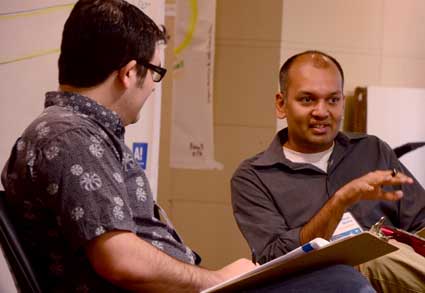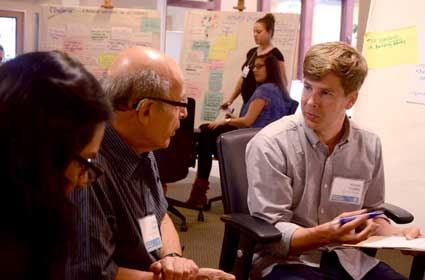Future Now
The IFTF Blog
At Talkoot, Small Makes for Big Changes
On July 30-31, the Institute for the Future, in collaboration with Aalto University in Finland, invited a dozen practical visionaries to reveal the design principles that have made their “outlier” innovations a success. The talkoot—a traditional Finnish gathering of friends to address a common concern—is part of an ongoing program to design more inclusive futures worldwide and learn from exceptional organizations. The result was a set of five epic challenges, a collection of design principles and a close look at the many ways that very small innovations can add up to a very big change in global equity and equality.
Practical visionaries are people who have a strong vision of a sometimes radically different future. But they are not simply thinkers. They are doers and makers, with hands-on experience in on-the-ground design and innovation to make their future visions a reality.

- IFTF’s David Evan Harris interviews Nipun Mehta of ServiceSpace about strategies for building an “ecosystem of generosity.”
For example, Nipun Mehta, founder of ServiceSpace, has built a chain of Karma Kitchens around the world based on the principle of paying it forward. Staffed with volunteers, the restaurant invites guests to “grow in generosity.” Menus have no prices and diners receive a bill that reads: “Your meal was a gift from someone who came before you. To keep the chain of gifts alive, we invite you to pay it forward for those [who] dine after you." Mehta’s vision is to build out the global ecosystem of generosity.
Katindi Sivi-Njonjo, from Kenya’s Society for International Development, spent the last few years working with Kenya’s youth to build a long-term vision for Kenya in 2030. Like many countries in Africa and the Middle East, Kenya is facing a youth bulge as young, primarily unemployed youth begin to enter an adult world with few opportunities to work and build a positive future for themselves. Her project not only gave Kenyan youth a chance to build a united voice, but the opportunity to express to policy makers the nuances of their needs and create a roadmap to a stable future that can prosper from a youth dividend.

- Three practical visionaries get a taste of one another’s perspectives at the opening reception for the talkoot. From left to right: Amanda Noonan of Internews Center, Amy Clark of Ashoka, and Jim Fruchterman of Benetech.
Amanda Noonan, from the Internews Center for Innovation and Learning, is working to build local capacity to turn information into power by collaborating with communities to build on their existing communication flows. She is working with refugees, rural communities, and disadvantaged groups in Tibet, Pakistan, Burma, North Korea, and other difficult-to-access locations to help people see how information is or is not flowing in their communities and to train a new generation of journalists.
Among the other practical visionaries who shared their visions and the hands-on insights into challenges and design principles were Lina Constanovici, who is the director of US operations for the first peer-to-peer micro-funding marketplace for startups; Heather Fleming, who leads a non-profit design and engineering firm aimed at providing design and technical capacity to disadvantaged communities; Jim Fruchterman, a founding visionary of the social entrepreneur movement; April Rinne, who uses microfinance tools to improve access to water a sanitation in the developing world; Rachael Caine, who builds the community of volunteers and interns at Kiva to broker peer-to-peer loans worldwide; Sari Stenfors, who is teaching innovative entrepreneurship in Afghanistan and other regions of instability through Innovation Democracy, Inc.; Amy Clark, who oversees the selection of the growing network of innovators and social entrepreneurs at Ashoka; Ervin Staub, a professor of psychology and peace and violence who has used his research to build radio programming in Rwanda, Burundi, and the Democratic Republic of Congo to promote psychological recovery and reconciliation; and Paula Goldman, who develops cross-sector partnerships and intellectual capital at the Omidyar Network to drive the firm’s philanthropic goals.

- Practical visionaries at the innovation talkoot seek design principles for building more inclusive futures. Foreground, left to right: Deepa Mehta of IFTF, Ervin Staub of University of Massachusetts, Amherst, and Markus Paukku, of Aalto University. Background, left to right: Jim Fruchterman of Benetech, Rachael Caine of Kiva, and Tessa Finlev of IFTF.
Raphaële Bidault-Waddington, a French artist who uses image architectures and conceptual diagrams to help envision the future, also participated as a practical visionary at the intersection of business, art, and urban development. Founder of the Paris-based Laboratoire d'Ingenierie d'IDées (Idea Engineering Lab), she is working closely with the IFTF and Aalto teams to capture the insights and spirit of the talkoot in an artistic interpretation of the event. Considered a global pioneer in art-based research and innovation, Bidault-Waddington is affiliated with the Sorbonne University Art & Flux international research chair and the New Club of Paris, a global network of intellectual capital and innovation experts.
The talkoot identified five “epic challenges” for building more inclusive futures, from building a global ecosystem of generosity-based practices and platforms to cultivating a more empathic human species. For each challenge, the practical visionaries suggested design principles to guide innovators worldwide. Prof. Liisa Välikangas, David Evan Harris, and Markus Paukku will introduce the challenges and design principles to students in a Fall 2012 course on development innovation at Aalto University to pilot a larger global challenge project.
The workshop was supported by The Outlier Initiative, a research project of Tekes, the Finnish Funding Agency for Technology and Innovation. Project co-leads were Liisa Välikangas and Kathi Vian. For more information, please contact Tessa Finlev at IFTF (tfinlev@iftf.org) or Markus Paukku at Aalto University (markus.paukku@aalto.fi).
About the Outlier Initiative
The Outlier Initiative is a research project that identifies and engages with frontrunner outlier organizations that drive the future. Based out of the Aalto University School of Business in Helsinki, Finland and funded by Tekes, the Finnish Funding Agency for Technology and Innovation, the Outlier Initiative collaborates with academia, business, and non-profit organizations internationally in studying highly impactful outliers and the system-wide changes they bring about.



